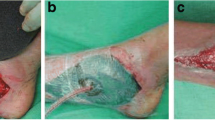Abstract
Background
The aim of this paper is to determine which therapy gives best results regarding process of healing of diabetic foot ulcers among three proposed: only negative pressure wound therapy, only hyperbaric oxygen therapy, and both when used in conjunction.
Methods
This bicentric prospective study included 60 patients, and they were, consecutively, assigned to one of three groups. The first group consisted of 20 patients who were treated only by hyperbaric oxygen therapy, second group consisted of 20 patients treated with combined hyperbaric oxygen and negative pressure wound therapy, and third group consisted of 20 patients who were treated only by negative pressure wound therapy. In some cases, previous revascularization of lower limb was performed and patients with poor run-off, without possibility to perform revascularization, were excluded from the study.
Results
Patients were predominantly men (56.7%) and mean age was 60.57 years. Majority of patients had ulcers of ischemic origin (45%), in 30% of cases, the reason of foot ulceration was neuropathy, and in 25% of patients, the etiology was combined. During the study, in three patients (5%), minor amputations were observed. Regarding Wagner classification of foot ulcers, most dominant was stage II (χ = 12.618, df = 4, p < 0.05). Statistically significant reduction of wound area was achieved when hyperbaric oxygen and negative pressure wound therapy were used in conjunction comparing to isolated use either of these two modalities of treatment (χ = 116.000, df = 44, p < 0.01).
Conclusion
Our data suggests simultaneous use of hyperbaric oxygen therapy and negative pressure wound therapy in diabetic foot ulcer treatment in order to achieve best results. Of great importance is previous wound debridement and successful limb revascularization.



Similar content being viewed by others
References
Resnick H, Shorrb R, Lewis Kullerc L, et al. Prevalence and clinical implications of American Diabetes Association defined diabetes and other categories of glucose dysregulation in older adults: The Health, Aging and Body Composition Study. J Clin Epidemiol. 2001;54:869–76.
Beckman J, Creager M, Libby P. Diabetes and atherosclerosis epidemiology, pathophysiology, and management. JAMA. 2002;287:2570–81.
Ramsey SD, Newton K, Blough D, McCulloch DK, Sandhu N, Reiber GE, et al. Incidence, outcomes , and cost of foot ulcers in patients with diabetes. Diabetes Care. 1999;22:382–7.
Singh N, Armstrong DG, Lipsky BA. Preventing foot ulcers in patients with diabetes. JAMA. 2005;293:217–28.
Brem H, Shehan P, Rosenberg HJ, et al. Evidence based protocol for diabetic foot ulcers. Plast Reconstr Surg. 2006;117:193S–207S.
Argenta LC, Morykwas MJ. Vacuum-assisted closure: a new method for wound control and treatment: clinical experience. Ann Plast Surg. 1997;38:563–76.
Wunderlich RP, Peters EJ, Lavery LA. Systemic hyperbaric oxygen therapy: lower-extremity wound healing and the diabetic foot. Diabetes Care. 2000;23:1551–5.
Frykberg R. Diabetic foot ulcers: pathogenesis and management. Am Fam Physician. 2002;66:1655–62.
Wagner FW Jr. The diabetic foot. Orthopedics 1987;10:163–172.
Blume P, Walters J, Payne W, et al. Comparison of negative pressure wound therapy using vacuum-assisted closure with advanced moist wound therapy in the treatment of diabetic foot ulcers. Diabetes Care. 2008;31:631–6.
Hopf HW, Humphrey LM, Puzziferri N, West JM, Attinger CE, Hunt TK. Adjuncts to preparing wounds for closure: hyperbaric oxygen, growth factors, skin substitutes, negative pressure wound therapy (vacuum assisted closure). Foot Ankle Clin. 2001;6:661–82.
Saxena V, Hwang CW, Huang S, et al. Vacuum assisted closure: microdeformations of wounds and cell proliferation. Plast Reconstr Surg. 2004;114:1086–96.
Ali Z, Anjum A, Khurshid L, Ahad H, Maajid S, Dhar SA. Evaluation of low-cost custom made VAC therapy compared with conventional wound dressings in the treatment of non-healing lower limb ulcers in lower socio-economic group patients of Kashmir Valley. J Orthop Surg Res. 2015;10:183.
Abidia A, Laden G, Kuhan G, Johnson BF, Wilkinson AR, Renwick PM, et al. The role of hyperbaric oxygen therapy in ischaemic diabetic lower extremity ulcers: a double-blind randomised-controlled trial. Eur J Vasc Endovasc Surg. 2003;25:513–8.
Löndahl M, Katzman P, Nilsson A, et al. Hyperbaric oxygen therapy facilitates healing of chronic foot ulcers in patients with diabetes. Diabetes Care. 2010;33:998–1003.
Margolis DJ, Gupta J, Hoffstad O, Papdopoulos M, Glick HA, Thom SR, et al. Lack of effectiveness of hyperbaric oxygen therapy for the treatment of diabetic foot ulcer and the prevention of amputation: a cohort study. Diabetes Care. 2013;36:1961–6.
Fedorko L, Bowen J, Jones W, et al. Hyperbaric oxygen therapy does not reduce indications for amputation in patients with diabetes with nonhealing ulcers of the lower limb: a prospective, double-blind, randomized controlled clinical trial. Diabetes Care. 2016;39:392–9.
Funding
This research received no specific grant from any funding agency in the public, commercial, or not-for-profit sectors.
Author information
Authors and Affiliations
Corresponding author
Ethics declarations
All patients gave informed consent to participate in the study, and Ethics committee of both institutions approved the conduct of the study.
Conflict of interest
The authors declare that they have no conflict of interest.
Additional information
Publisher’s note
Springer Nature remains neutral with regard to jurisdictional claims in published maps and institutional affiliations.
Rights and permissions
About this article
Cite this article
Matic, P., Cejic, D., Tanaskovic, S. et al. Results of simultaneous application of hyperbaric oxygen and negative pressure wound therapy in diabetic foot ulcers treatment. Int J Diabetes Dev Ctries 39, 654–658 (2019). https://doi.org/10.1007/s13410-019-00737-y
Received:
Accepted:
Published:
Issue Date:
DOI: https://doi.org/10.1007/s13410-019-00737-y




